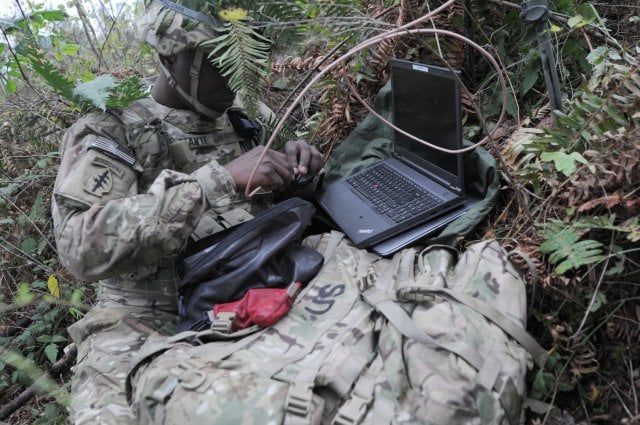By SYDNEY J. FREEDBERG JR.

WASHINGTON: Army commanders in the Pacific “really get it” when it comes to cyber/electronic warfare so Army Cyber Command is stepping up collaboration and exercises with them, said ARCYBER’s three-star chief.
Army Cyber has grown dramatically since its founding a decade ago, Lt. Gen. Stephen Fogarty told AFCEA’s TechNet Augusta conference Tuesday. “I would give ourselves probably a solid B, B-plus,” he said candidly. “It’s not for lack of effort. It’s just this is really complex.”
“As we continue to increase the amount of operations, the variety of operations we’re conducting, we learn something every single day,” he said.
ARCYBER’s central mission is to support commanders around the world, and the cyber-savvy of those commanders matters immensely to how well cyber capabilities get used. “Our commanders are seeing [that] wherever they’re deployed – particularly those that are in Europe and in the Pacific – they’re just under constant, constant assault,” Fogarty said, both in cyberspace and by electronic warfare. But, he admitted, “not all commanders are at the same level.”
Fortunately for the Army, Fogarty finds some of its most forward-thinking commanders in the Pentagon’s top priority theater, the Pacific. In particular, Lt. Gen. Randy George is a “real visionary,” Fogarty said. George leads Fort Lewis’ I Corps, which controls the Army’s first Multi-Domain Task Force, an experimental unit that combines long-range rocketry with a full battalion developed to Intelligence, Information, Cyberspace, Electronic Warfare, & Space (I2CEWS). Fogarty also praised the commander of the Hawaii-based 25th Infantry Division, Maj. Gen. James Jarrard, and the overall commander of US Army Pacific, Gen. Paul LaCamera.
“They all really get it…. They have to get it to operate as effectively as we need them to,” Fogarty said.
While the Army is building up its cyber/electronic warfare force and adding more personnel and new technology at multiple levels, the Pacific commanders are already innovating with what they have. “They’re not waiting for doctrine. They’re not waiting for the formal capabilities. In a lot of cases they’re just organizing organically,” Fogarty said, “and so they’ve become one of our partners of choice.
“This summer, we’re going to present our full range of capabilities out in the Pacific in a way we have not done out to this point,” he said. “We’re going to learn a lot, and we may not get it all right, but they’re willing to roll up their sleeves and help really us tune our capabilities.”

A soldier from the Army’s offensive cyber brigade during an exercise at Fort Lewis, Washington.
A Constant Global Struggle
Which capabilities? Fogarty didn’t specify what would get a workout in the Pacific, but he did overview Army Cyber Command’s rapidly growing capabilities writ large.
ARCYBER is like “an internet startup that’s starting to scale,” Fogarty said. Most of its personnel, time, and bandwidth (literal and metaphorical) remained devoted to defending US networks around the world, he said. But ARCYBER is increasingly delegating network security to Network Enterprise Technology Command (NETCOM) in Fort Huachuca, Ariz., freeing up Fogarty’s Fort Gordon, Ga. headquarters to do more cyber offense and online information & influence operations.
Critical to this effort are a highly educated workforce – a third of enlisted personnel enter the cyber branch with a bachelor’s degree, an attainment traditionally reserved for officers – and new $366 million headquarters facility at Fort Gordon. Named Fortitude Hall, it boasts 300 on-site servers, more than 3,000 miles of wiring and high-speed connections to everything from the NSA to allies.
So it’s not just a building. “I’m sitting in a purpose-built global power projection platform,” Fogarty said. “The cyber weapon system actually resides here…. We’re conducting operations 24-7 from this facility and other facilities like it.”
That includes operations not only in “blue space” – on US and allied networks – but in “grey space” – neutral nations’ networks – and even “red space” – adversary networks. That’s in keeping with the doctrine of “persistent engagement” and “hunt forward” promulgated by Gen. Paul Nakasone, the Army four-star who heads the NSA and the all-service Cyber Command.
“Persistent engagement… it was a recognition that if we were going to really survive, that we could not cede any of the operational depth,” Fogarty said, “so we had to be competing and contesting both in red space and in grey space. We couldn’t just give them freedom of movement. We couldn’t allow them sanctuary to rehearse and develop capabilities that they would later throw against us. You couldn’t be hunkered down in blue space with your shields up hoping that defense in depth would keep the arrows from slipping through.”
America’s adversaries are constantly improving their defenses and testing ours, and technology is constantly advancing. So there’s no endpoint at which you can stop improving, Fogarty said. “Every time I think we’re close, the adversary raises the bar,” he said. “[Or] we see something in academia or commercial side or maybe a joint capability or a partner capability that convinces me, yeah, we can do it better – very importantly, we can do it faster.”
“You may come in day after day after day and not be able to have a breakthrough, and so our force has to be resilient,” Fogarty added. “As I talk to our lieutenants, as I talk to our young sergeants, I say, look… you have to be able to deal with failure, sometimes over and over and over again, but not give up. You’re going to have to figure out a way to adapt and overcome and outwit our adversaries.”
“And,” he said, pointing to recent hacks like SolarWinds, Microsoft Exchange, and Colonial Pipeline, “the stakes could not be higher.”
No comments:
Post a Comment